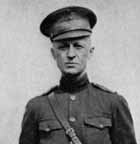


|
The marrow of the tragedy is concentrated in the hospitals . . . . Well it is their mothers and sisters cannot see them---cannot conceive and never conceived these things . . . . Much of a Race depends on what it thinks of death and how it stands personal anguish and sickness . . . . ---WALT WHITMAN, Memoranda During the War |
IT is seldom realized how few of our contemporaries possess or seek to cultivate the diarist's habit. The tension of modern living, with its inevitable physical fatigue by nightfall; the availability of telephone, telegraph, and typewriter, which so facilitate our transaction of business and our communication of family affairs ---fast living and ready service have between them curbed the impulse to jot down those personal records which so often illuminate our knowledge of the past. People to-day lack the incentive to rise as early as Pepys, or the persistence to write as late as Boswell. Good diarists are few and far between, and their paucity will be felt in the future.
There are of course exceptions, as this volume goes to show. Of the various arms of the service engaged in the Great War, the Medical Corps was surely the most humane and probably the best capable of "a long and dispassionate view." Army regulations did not encourage the keeping of diaries, but we know that the staff officers at headquarters set down their daily impressions, while in small dog-eared volumes many men in the front lines made penciled notes of their experiences. Those that have been preserved, in so far as they give an intimate picture of the war, are of utmost importance in strengthening our minds against the suicide of such another conflict. But no record of the war is complete until we have heard from those skillful and tireless noncombatants, the surgeons and nurses who fought for life in the hospitals behind the lines, taxing their skill and their pity to repair what the guns had done.
Dr. Cushing saw the war on the Western Front at close quarters. His first duty was in the early spring of 1915 when he served with a Harvard Unit in the American Ambulance at Neuilly, France. At that time he became familiar with the French Service de Santé. From Paris he went on a visit to the Royal Army Medical Corps and saw at first hand their work in Flanders. On his return to this country, as part of the preparedness campaign, he set about organizing one of the Base Hospital Units which were recruited from the professional staff of a number of university medical schools. As director of one of these units, known as Base Hospital No. 5---the second military organization of any kind officially sent overseas---he sailed for France again in May 1917. Throughout that year he served as an operating surgeon with the B.E.F., being detached from the Unit for special duty during the battles for the Messines and Passchendaele ridges. In June 1918 he was transferred to the Medical Headquarters of the A.E.F. as senior consultant in neurosurgery, and participated in the three major engagements at Château-Thierry, St. Mihiel, and the Argonne.
In between these major offensives, Dr. Cushing was performing a hundred different duties: he visited with the Canadians and the Anzacs; he attended the medical conferences in Paris; he crossed the Channel to be with Osler and to confer with the medicos in Oxford and London; he visited the front lines; he knew about the postes de secours and the ambulance trains and casualty clearing stations; his operations on wounded men were critical and prolonged, and during times of pressure he was sometimes on duty sixteen hours at a stretch.
Throughout these periods of incredible industry, working under a strain to which doctors are seldom exposed in times of peace, he still managed to keep, with few intermissions, a day-to-day record, not only of his surgery but of the extraordinary soldiers, scientists, poets, and philosophers whom he encountered in his tours of the lines. Bits of comedy, acts of uncommon heroism, the everlasting conflict of nationalities, snatches of history, thumb-nail sketches of the Flanders countryside, of night bombing, of the Hindenburg Line, of Paris in ferment---all this was written down with the sensitive and observant eye of a scientist The journal was kept in longhand, on the backs of used temperature charts, X-ray reports, or such other scraps when paper was scarce; it was written often at night---sometimes as late as two in the morning---but written down when the emotions were alert and before the day's events had been erased by sleep.
The author almost never alludes to the actual business of keeping such a record. Once he remarks sotto voce, "The ambulance is jiggling so I find it hard to write"---evidence that his chronicle was sometimes set down as he motored from hospital to hospital. And in September 1917 he utters this brief expostulation, the truth of which will be instantly recognized by anyone who has ever kept a diary in the past:
I have neglected this diary for a week and find myself somewhat weary of it. It is costly in time, in paper and ink---three things of which there is no superfluity hereabouts. I have, too, been having a mental let-down ----probably subdiaphragmatic in origin, and writing at such times is not easy. The writing centre is not in the angular gyrus, it 's in the gastric mucosa.
Dr. Cushing's journal, complete with the maps, illustrations, letters, and orders, to-day fills nine bound volumes in his library. From its bulk of a million words this single and arresting volume has been culled, representing, as the editor believes, material of lasting interest to physicians, veterans, and the discriminating reader.